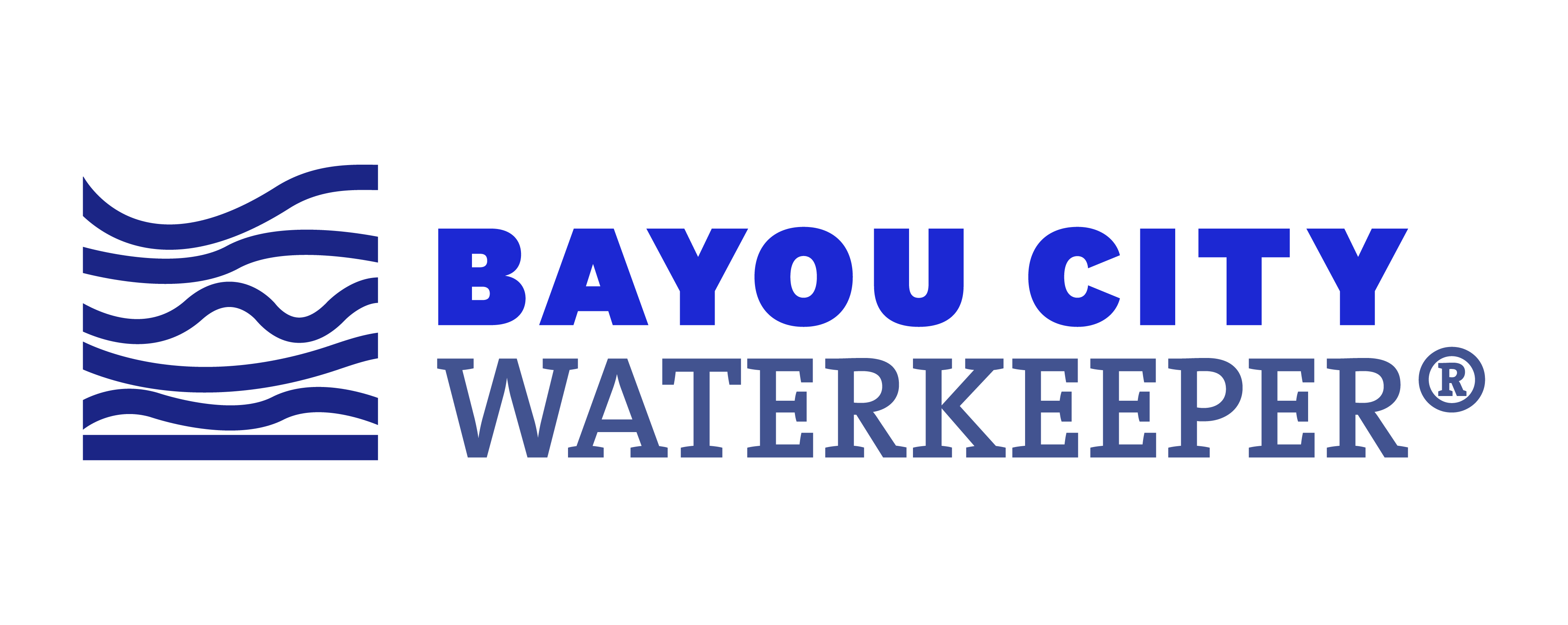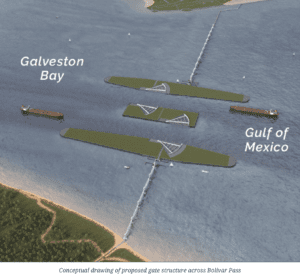[vc_row][vc_column][vc_btn title=”Take Action: Tell the Corps to Protect Galveston Bay and its Communities” color=”black” size=”lg” align=”center” button_block=”true” link=”url:https%3A%2F%2Fbayoucitywaterkeeper.salsalabs.org%2Faction_coastalbarrier2020||target:%20_blank|”][vc_column_text]Update (4 Dec 2020): Thanks to your efforts, the Army Corps has extended their comment period to January 13, 2021! However, if you’d like to make a verbal comment, the last public meeting will be hosted on December 8th at 11:00 am and 6:00pm. Register to attend here.
It’s been two weeks since the Army Corps released the updated draft of the Coastal Texas Study and there are still questions and concerns that need to be answered.
Over the last five years, the Army Corps of Engineers has been engaged in a study to determine the best method to protect the communities and industry residing along the Texas Coast. The Coastal Barrier along Galveston Island and Bolivar Peninsula, the most expensive component of the Coastal Texas Study, has undergone many iterations since its inception 2009, including the “Ike Dike” and the “Coastal Spine”. The proposed Coastal Barrier will likely be the most complex and costly structure of its kind in the United States.
The Army Corps is scheduled to issue a final plan by February 2021, after completing its final public review for its revised Feasibility Report and Environmental Impact Statement currently out for public comment. As the Army Corps finalizes its proposed coastal projects, there are many lingering questions and concerns about the risk to Galveston Bay, the financial and economic cost to our communities, and the effectiveness of its design. The current design of the Coastal Barrier includes a series of gates that will stretch the two-mile length of Bolivar Roads, twin sand dunes (12 and 14-foot high), and an expansion of the beach 250 ft gulfward across most of the shoreline on Bolivar Peninsula and Galveston Island. The design also includes a ring barrier around the eastern portion of Galveston Island to address bayside flooding, and investments in ecosystem restoration. The total cost of the Coastal Barrier now totals between approximately $14 and 18 billion.
One of our critical concerns is that the proposed plan only addresses one symptom of hurricane disasters: surge from the Gulf of Mexico. While surge is an important harm to mitigate, recent storms, like Hurricane Laura in Southwest Louisiana and Hurricane Harvey, caused more damage due to devastatingly high wind speeds and record floods from rain – neither of which the Coastal Barrier will mitigate for. Since its inception, serious concerns have been raised regarding the environmental risks to the health of Galveston Bay and the exorbitant cost for inadequate protection to our coastal and inland communities and industries, should the surge barrier be built. As the second most ecologically productive estuary in the United States, environmental harm to the Galveston Bay ecosystem will undoubtedly result in economic losses for our region. Current modeling from the Army Corps shows the 2-mile long gates structures will reduce the natural flow of water between Galveston Bay and the Gulf of Mexico. Reduced flows can restrict movement of marine species, as well as drastically change salinity and circulation within Galveston Bay.
The dune system is also problematic in terms of the amount of material required. Construction of the twin dune system will require 60 million cubic meters of sand, representing a significant beach expansion and a hefty price tag. It is unclear whether this quantity of sand is even readily available, according to leading experts such as retired geologist Rice University professor Dr. John Anderson. Finally, the timetable for the Coastal Barrier implementation, and the duration of the project lasting about 50 years, makes the entire project seem like folly. It is estimated that the complete evaluation of impacts to the Bay and structural design of the completed Coastal Barrier will take 2-5 years at a minimum, once funds are appropriated by Congress. That would then be followed by another 10-15 years to construct. Assuming immediate funding in full and a steady construction schedule, the soonest the completed Coastal Barrier could be in place would be 20 years. And this would only last for 50 years, providing limited flood and storm risk mitigation.
Understanding this timeline is important, as there are better, more cost-effective and time-sensitive alternatives that could be implemented in its place. Taxpayers across the coast and within Harris County will likely be on the hook for the local match required for this project (35% from a local sponsor, 65% from the Army Corps), and will be responsible for the annual operations and maintenance costs associated with this project – ranging upwards of $100 million per year. We’re calling on the Army Corps to consider more cost-effective and less environmentally destructive options – such as funding for non-structural projects, like elevating homes and engineering them to withstand surge, wind and flood; restoring the natural environment, like coastal wetlands, marshes and oyster reefs to lessen the impacts from surge; and limiting structures in flood risk areas and ecologically vulnerable places, to ensure that people remain out of harm’s way. Regarding the risk of spills of petroleum and petrochemicals from storage tanks along the Houston Ship Channel, an in-depth study to determine if the risk can be mitigated with targeted, industry-funded interventions – such as raising existing flood protection levees. Protecting our communities is critical; but we shouldn’t wait for a “silver bullet” solution that will take decades to build and could potentially destroy Galveston Bay.
The time for action is now. Tell the Army Corps that you want a project that doesn’t pose significant risk to Galveston Bay and our communities.
[/vc_column_text][vc_row_inner][vc_column_inner width=”1/2″][vc_btn title=”Take Action: Tell the Corps to Protect Galveston Bay and its Communities” color=”danger” size=”lg” align=”center” link=”url:https%3A%2F%2Fbayoucitywaterkeeper.salsalabs.org%2Faction_coastalbarrier2020||target:%20_blank|”][vc_btn title=”View Recording of Coastal Barrier Meeting (Nov 19, 2020)” color=”success” size=”lg” align=”center” link=”url:https%3A%2F%2Fwww.youtube.com%2Fwatch%3Fv%3DZTMq9PTF-8o||target:%20_blank|”][/vc_column_inner][vc_column_inner width=”1/2″][vc_btn title=”Attend US Army Corps’ Formal Public Comment Session (Virtual): Final Public Meeting December 8th” color=”blue” size=”lg” align=”center” link=”url:https%3A%2F%2Fcoastalstudy.texas.gov%2Fget-involved%2Fpublic-meetings%2Findex.html||target:%20_blank|”][vc_btn title=”Read & Download Coastal Texas Feasibility Study” color=”warning” size=”lg” align=”center” link=”url:https%3A%2F%2Fbit.ly%2F2020feis||target:%20_blank|”][/vc_column_inner][/vc_row_inner][/vc_column][/vc_row][vc_row][vc_column][vc_column_text]Visit the Coastal Texas Study website to learn more and participate in the formal public meetings, hosted by the Army Corps of Engineers. To register and attend these virtual public comment meetings, click here. You can submit comments on this project at one of these meetings, by email, or by mail. Be sure to copy your elected official and let them know your concerns! The Comment Deadline is January 13, 2021.[/vc_column_text][/vc_column][/vc_row][vc_row][vc_column][vc_single_image image=”2229″ img_size=”full” alignment=”center” onclick=”custom_link” link=”https://bayoucitywaterkeeper.salsalabs.org/action_coastalbarrier2020/index.html”][/vc_column][/vc_row]

